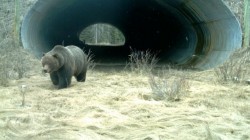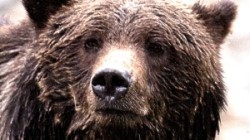News & Media
Banff bears use Trans-Canada wildlife crossings to find mates; wildlife crossings can cost up to $4M each, but benefit bear populations



Grizzly and black bears are looking for love on both sides of the Trans-Canada Highway, and using wildlife crossings to rendezvous with members of the opposite sex, a new study confirms.
Scientists had previously been concerned that the highway, which is fenced on both sides through Banff National Park, might block animals from breeding with others of their species on the other side of the highway. That, in turn, could lead to isolation and inbreeding.
And while Parks Canada found that the fencing and 44 crossings did reduce wildlife collisions by 80 per cent, it wasn’t clear whether animals used the crossings to find mates.
Now, a new genetic analysis of bear hair samples by researchers at Montana State University shows the bears are indeed crossing the highway to mate with bears on the other side.
One black bear male in the study, mated with at least five different females and fathered at least 11 offspring while crossing back and forth, said Michael Sawaya, lead author of the study published Tuesday in the journal Proceedings of the Royal Society B.
That male, he observed, “certainly has found that he has increased his own breeding opportunities by having access to both sides of the highway.”
While the analysis couldn’t determine whether crossing the highway made animals more successful breeders, at first glance it seemed that might be the case, the paper said.
According to Parks Canada, the 83 kilometres of the Trans-Canada Highway passing through Banff were upgraded to a four-lane divided highway from two lanes in 1981. Subsequently, fencing was added on both sides of the highway to reduce collisions between vehicles and wildlife.
“It was a huge safety problem,” Sawaya said in a phone interview.
Over the course of three decades, 44 wildlife crossings, including 38 underpasses and six overpasses, were built across the highway.
Overpasses can cost millions
Sawaya said it typically costs $2 million to $4 million to build and landscape an overpass crossing, although the underpasses typically cost less than a tenth of that.
The crossings are used by a range of wildlife, including wolves, elk, moose, deer, bighorn sheep, coyotes, wolverines, lynx, and cougars.
Initially, grizzly bears were reluctant to use the crossings – it took five years for the bears to gradually get used to them. Because of that and the high cost, some people have questioned whether the crossings are worth it and whether more such structures should be built in other parks.
Sawaya said the results of the study should put those doubts to rest.
“We’ve given enough evidence now to show that they work,” he added. “Those concerns should no longer be what hold people back.”
Sawaya and his colleagues used strands of barbed wire to collect thousands of bear hair samples both in and around 20 crossings in the Bow Valley and in the surrounding area between 2006 and 2008.
They tested the DNA and discovered that a large number of black and grizzly bears were using the crossings. While previous research suggested that most of the bears using the crossings were too young to breed, the new study found that almost half of black bears who used the crossings and almost 30 per cent of grizzly bears who used the crossings bred successfully during the study.
The genetic analysis also suggested that indeed, the highway used to keep grizzly bears from the north side from breeding with grizzlies on the south side were causing the animals to become inbred.
Sawaya thinks the wildlife crossings are starting to restore the gene flow between grizzlies on both sides of the highway.
“But this takes time,” he said.
Besides using the wildlife crossings to look for mates, there is evidence that animals also use them to find food, shelter or escape from predators.
![ARC [diagram]](https://arc-solutions.org/wp-content/themes/arc/images/arc-diagram.jpg)
